Photo


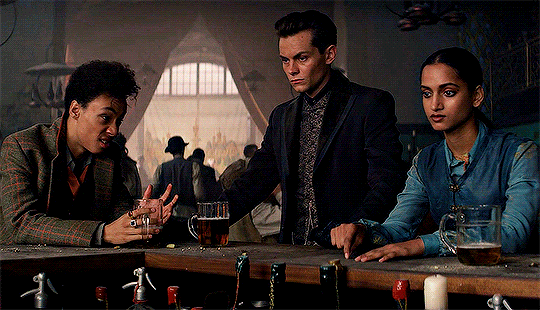
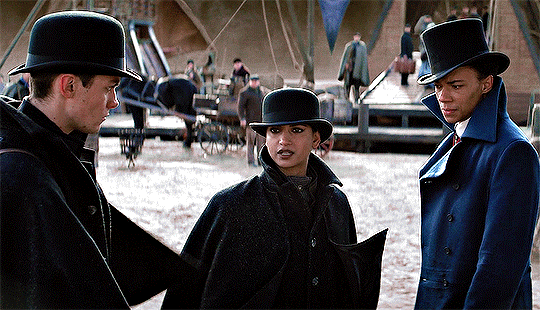

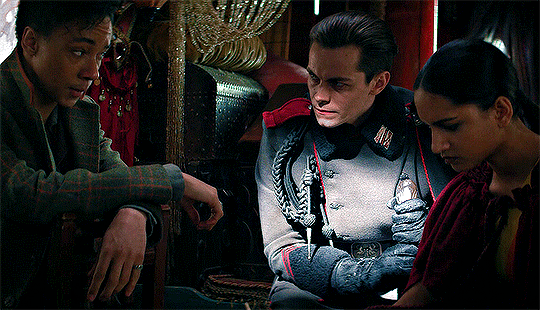

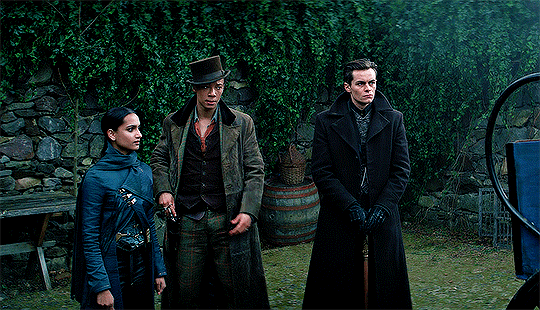

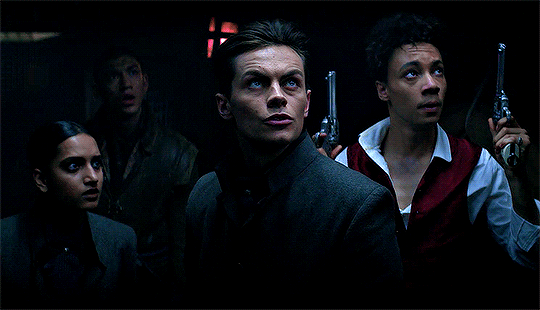
Crows don’t just remember the faces of the people who wronged them. They also remember those who were kind. They tell each other who to look after and who to watch out for.
21K notes
·
View notes
Photo


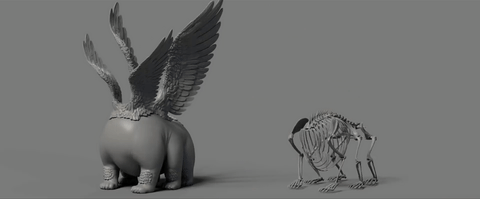
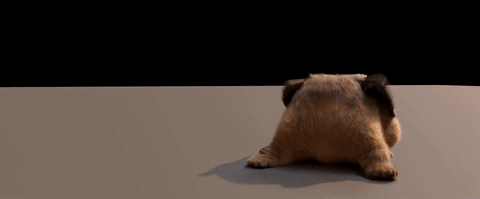

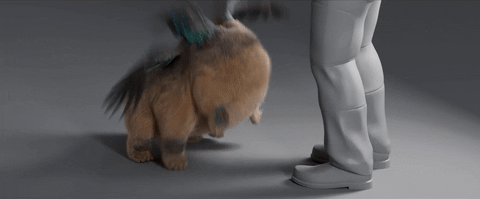

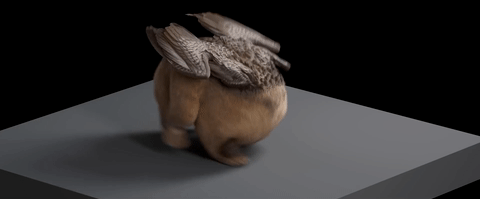
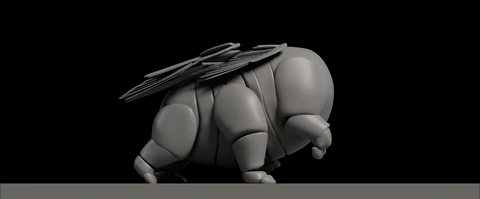
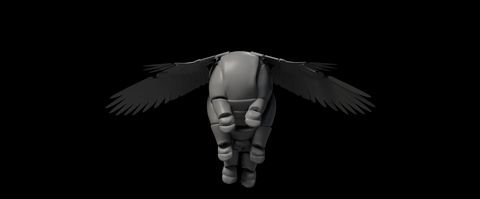
Morris’ Origins | Marvel Studios’ Shang-Chi and The Legend of The Ten Rings
TRIXTER VFX
743 notes
·
View notes
Photo
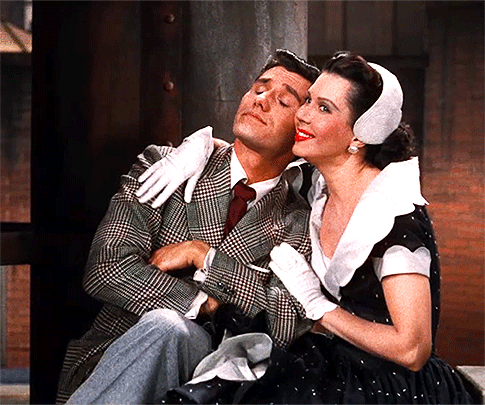

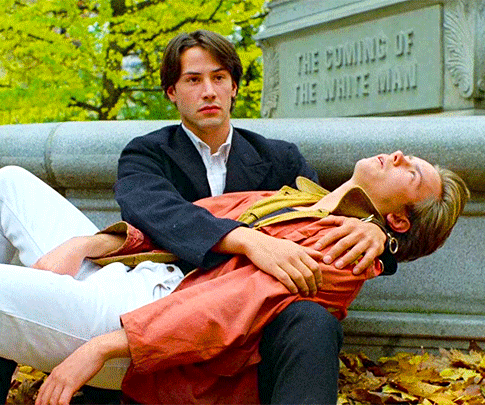

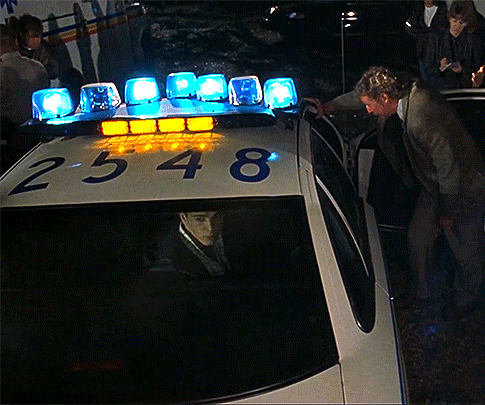

Modern Adaptations to William Shakespeare’s work:
Kiss Me Kate (1953, USA) Dir. George Sidney -> The Taming of the Shrew
Valley Girl (1983, USA) Dir. Martha Coolidge -> Romeo and Juliet
My Own Private Idaho (1991, USA) Dir. Gus Van Sant -> Henry IV, Part 1
10 Things I Hate About You (1999, USA) Dir. Gil Junger -> The Taming of The Shrew
O (2001, USA) Dir. Tim Blake Nelson -> Othello
Get Over It (2001, USA) Dir. Tommy O'Haver -> A Midsummer Night’s Dream
932 notes
·
View notes
Quote
You have to finish things — that’s what you learn from, you learn by finishing things.
Neil Gaiman (via writingdotcoffee)
752 notes
·
View notes
Photo


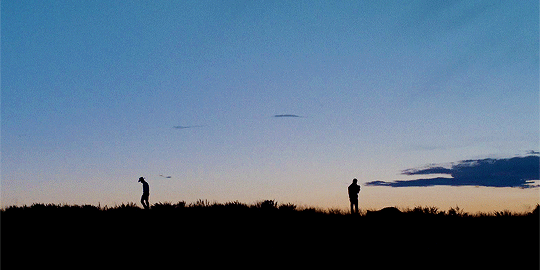
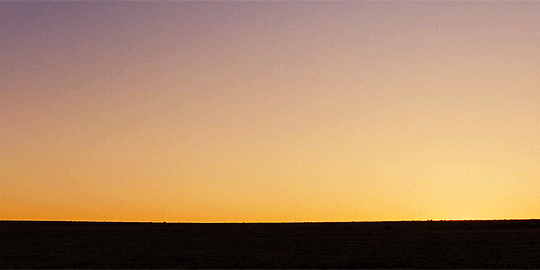


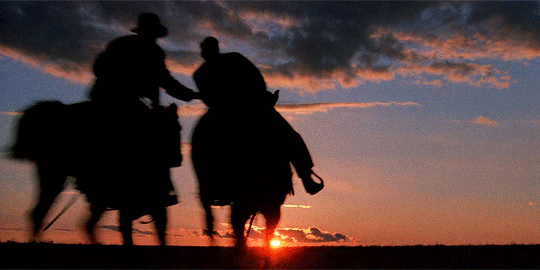


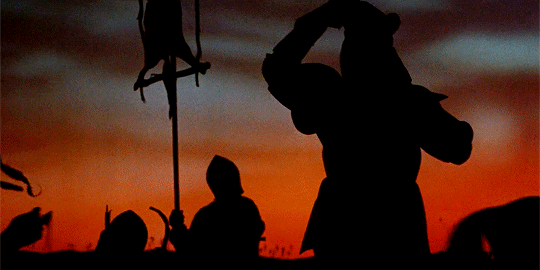
CREATORHUB SUMMER EVENT 2021: Day 01 - COLOR
SILHOUETTES AND THE SKY
The Lord of the Rings: The Fellowship of the Ring (2001) dir. Peter Jackson
Harold and Maude (1971) dir. Hal Ashby
The Rider (2018) dir. Chloe Zhao
True Grit (2010) dir. Joel and Ethan Coen
Easy Rider (1969) dir. Dennis Hopper
Mr. Turner (2014) dir. Mike Leigh
Indiana Jones and the Last Crusade (1989) dir. Steven Spielberg
Noah (2014) dir. Darren Aronofsky
Sicario (2015) dir. Denis Villeneuve
Bram Stoker’s Dracula (1992) dir. Francis Ford Coppola
3K notes
·
View notes
Quote
Shoot for the top, always. You know you’ll never make it, but what’s the fun if you don’t shoot for the top?
Ursula K. Le Guin (via writingdotcoffee)
342 notes
·
View notes
Text
How I Use Highlights in Writing Analytics
I’ve been using the highlights feature in Writing Analytics a lot recently, and it’s helped me eradicate a few annoying bad habits. Every time I write a word or a phrase I’m trying to use less, the editor highlights it straight away. That makes me aware of the mistake, and I can rephrase the sentence.
In this post, I want to share my setup and a few tips on how to make the most of this feature.
What are Highlights?
In Writing Analytics, you can tell the editor to highlight words and phrases of your choice. You can choose a colour for each one. The editor will show these as soon as you type them in.

To set them up, click on the menu icon in the top left corner, then Highlights. A window will pop up where you can add your highlights.
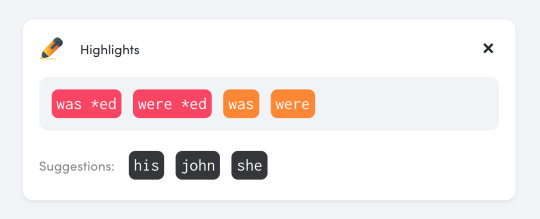
When you’re done, click the X icon to close the window and go back to writing.
The Idea
Every writer has a few words and phrases that they reuse way too much. Over time, you develop a spidey sense when you’re writing these. How many flipping times have I used ‘if’ in this piece?
The problem with that is that it’s often wrong. So many times I’ve gone back during revision to search for the offending words to find out that there was just one. If I knew that when drafting, I wouldn’t have to be anxious about it.
Loads of tools do grammar checks or help with line-level edits — like Grammarly or ProWritingAid. The problem is that they give you all sorts of weird suggestions from their algorithm that you don’t want to see. Like this one:
Custom highlights give you the power to decide what you’d like to see highlighted so you can target specific issues rather than doing everything at the same time. You can focus on the issues you’re struggling in your writing.

My Setup
At the moment, I use the highlights like these for pretty much every session:
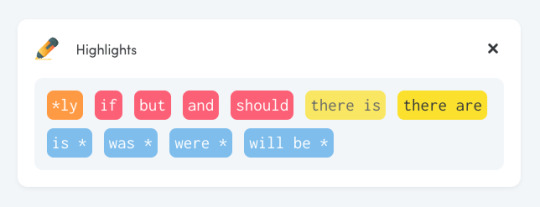
These will highlight most bad adverbs, passive voice and words that I’m trying to use less (if, but, and, should).
Adverbs
The *ly highlight is a wildcard. It will match all words that end with ly. It’s not perfect — some words that end with ly aren’t adverbs (and some adverbs don’t end with ly), but it’s good enough most of the time. It makes hunting for pesky adverbs so easy.
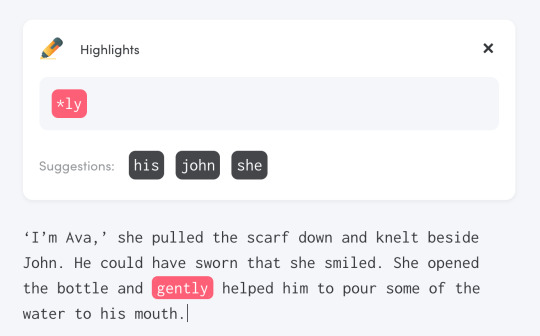
I prefer using orange as the colour for this highlight. Sometimes, I want to keep the adverb, or it’s a false positive. Orange is pretty easy on the eyes.
Bad Habits
My personal bad writing habits include over-complicated sentences — ifs, buts and shoulds. I also use and way too much sometimes. I’ll search for these during editing, but Having a highlight set up means that I can catch them while drafting.

Of course, these aren’t bad every time, but I want to know when I have four buts in one sentence so I use the red colour for these.
Passive voice
Even though I use passive voice sometimes, I want to avoid it wherever possible. Based on the tense I’m writing in, I usually include some of these highlights for passive voice:

There is/there are
When writing non-fiction (like blog posts), I use these way too much. For some reason, I almost always fail to spot these during editing 😅. It’s like they’re invisible to me.

Creating a highlight makes finding them super easy.
Narrative flow
When writing interactions between characters in fiction, I’ll often highlight the character names and their pronouns. That helps me figure out how much space each character gets on the page.
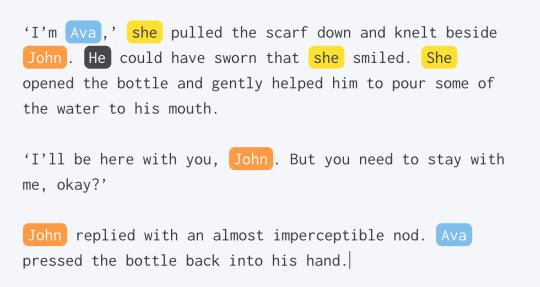
It’s also a fantastic tool for visually checking that the pacing of your dialogue isn’t way off.
Final thoughts
Highlights work great when first drafting or revising (if you prefer not to make any edits when first drafting). Use them to work on your bad writing habits or target common issues in your drafts. Then you can focus on the more complex issues when you do a full read-through.
Want to give this feature a try? Writing Analytics is free for the first two weeks.
312 notes
·
View notes
Photo

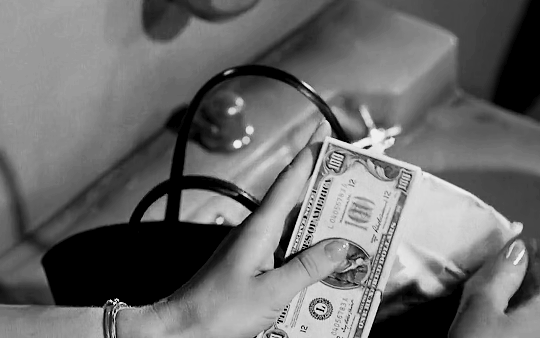


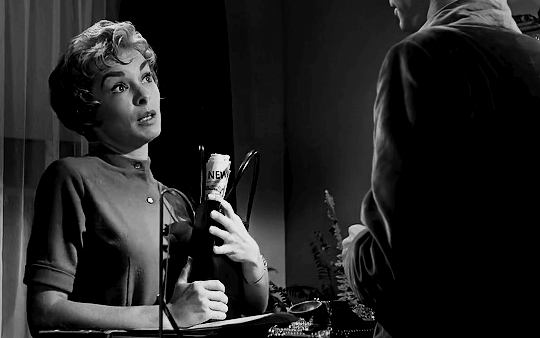

PSYCHO, 1960
dir. by Alfred Hitchcock
1K notes
·
View notes
Quote
Read, read, read. Read everything — trash, classics, good and bad, and see how they do it. Just like a carpenter who works as an apprentice and studies the master. Read! You’ll absorb it. Then write. If it’s good, you’ll find out. If it’s not, throw it out of the window.
William Faulkner (via writingdotcoffee)
699 notes
·
View notes
Photo





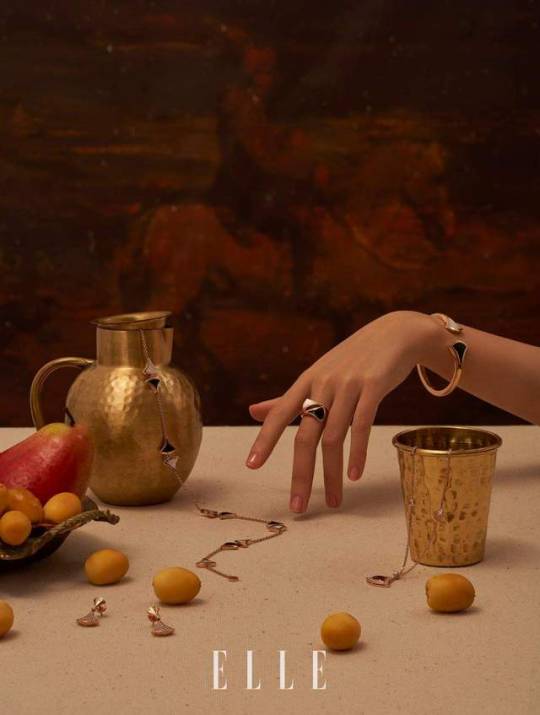
Trà My as Johannes Vermeer’s The Girl with a Pearl Earring reimagined by Dzũng Yoko for ELLE Vietnam August 2018.
57K notes
·
View notes
Photo


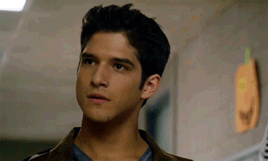
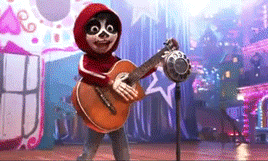

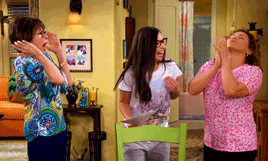
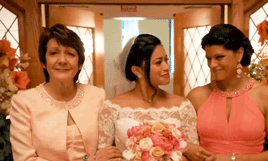



Happy Hispanic Heritage Month (September 15-October 15)! Here are (some of) my favorite Latinx characters in popular media!
6K notes
·
View notes
Text
#212: How to Turn an Idea into a Story

Thanks to dryadbucky for his question that inspired this post!
Ideas are weird. They come in all sorts of shapes and sizes. Sometimes, you’re standing in the street, and you get this odd feeling that it would be a great place for a story. A person walks past; it seems that they would make a perfect character. Or you’re just sitting at your desk, asking a series of ‘what-if’ questions. What would happen if the human civilisation evolved to live underwater?
Sometimes, when you get an idea, it seems like that’s the whole story. Then you sit down to write and find out how wrong you were.
Stories are 🔥
Think of stories as fire. Ideas are the sparks. But you can’t start a fire with just sparks alone. You’ll need a whole bunch of sparks and some flammable material too.
An idea needs to be kindled and developed into something that will satisfy readers. But what sort of flammable material do you need?
Story structure
The flammable material is story structure. To turn a bunch of ideas into a story, you have to have a good understanding of what makes a good one first.
Developing a story will be very difficult if you don’t know what you’re aiming for. It’s like asking someone who has no idea how engines work to build a car. Every car is different, but they all work along with the same general principles. Story structure is that but for writing.
When you know why stories can be broken down into three acts and what happens in each one; when you’re familiar with what makes a good character arc and what makes characters relatable; when you know how structure each scene, you’ll be able to turn almost any idea into a story.
Learning story structure
This will take some time. It certainly took me a while before I got a good grasp of it, and honestly, I’m still learning. I’ve read at least a dozen books on structure, and I’d recommend reading more than one to get different perspectives from various authors. After a while, you’ll realise that they’re all talking about the same thing from different angles.
My favourites include Story Grid by Shawn Coyne and Into the Woods by John Yorke, but there are many others that people recommend. Save the Cat by Blake Snyder, Story by Robert McKee, Anatomy of Story by John Truby to name a few.
Keep working on stories while you’re learning the principles. Every time you get stuck or can’t make something work, learn more about that aspect of storytelling. Maybe your characters aren’t relatable enough? Or perhaps you’re struggling with writing scenes? Or your story doesn’t have a climax? There are many great online resources about storytelling.
How I do it
Here’s how I go from a bunch of what-if ideas to a developed story. I’m not saying this is necessarily the right way to do it. But that’s what I’ve got.
Step 1: Where do your ideas fit?
First, I want to take a look at what I already have. Do I have an idea for a character or setting? Do I have an idea for a specific scene?
The 'what if the human civilisation evolved to live under water’ idea from above isn’t very specific. There aren’t any characters or detailed settings. It’s more of a theme.
In this case, I’d do a little more world-building to gather more clues. Maybe there are two factions — one in the Atlantic and one in the Pacific Ocean? Each should have an ancient capital city. I’d probably try to make these factions oppose each other — maybe they’re competing for resources? Maybe they’re having a cold war situation going on? Any conflict that you can get will be a fertile ground for more story ideas.
Step 2: What’s the climax?
I like to think about the climax first. The climax is the most important bit — that’s what the entire story will be building up to. If the climax falls flat, your readers won’t be happy regardless of how amazing the rest may be.
When you have the climax and resolution figured out, find ways to connect it to the other aspects of your story.
In this case, let’s say the conflict between the Atlantic and Pacific factions develops into a full-on war. One side is about to destroy the other’s capital city. If things go that far, there will never be peace.
Maybe the protagonist is a secret agent that knows that the conflict is actually stoked by a small, elusive group that wants to cause chaos and take control when both sides are weak. That’s the twist.
The climax of the story would be a scene where they’re about to nuke the city, but the protagonist just manages to stop it.
In the resolution, the two factions would start talking to each other, and there would be a pathway to peace or even reconciliation.
Step 3: Work backwards and fill in what’s missing
I like to work backwards from the climax. What would need to happen for things to end up in that place? How does the agent learn about the conspiracy? How does the war escalate this far? Who are the people running the secretive organisation? How is the protagonist affected by the story — what’s their character arc?
At this point, you can layer in subplots as well. Maybe the protagonist has a private life too? A partner that dies during the sieges?
And what’s the story of the villains? Are they just straight-up baddies, or is there more to why they want to take over the two oceans?
Keep doing this until you have everything you need — from the inciting incident to the resolution. That’s why understanding story structure is so important — you have to know what’s missing.
Step 4: Iterate
At this point, I’ll have loads of notes, lists, character profiles and whatnot. I’ll also have a bunch of mind maps (those to help me think).
Sometimes, plot holes or conflicting ideas sneak in as I’m building the story up. Now is the time to fix those and clean things up. For longer projects (like a novel), I’ll go back to some of my favourite story structure books to re-read some passages that I’ve highlighted to make sure I haven’t missed anything.
The whole process feels like a balancing act. I’m rarely happy with everything, but I try not to get caught up on anything for too long.
Step 5: Create a list of scenes
Before I start writing, I like to create a detailed list of scenes from all the notes that I’ve captured — that’s my outline. Again, understanding how scenes work and how to structure them will be invaluable at this stage (I learned this primarily from Story Grid).
Some will be easy to figure out (the ones based on your major plot points). Others will be a lot more work (some scenes will have to do multiple things — it’s a one big balancing act). The goal is to have a sequence of scenes that tells the story you want to tell while hitting all the right plot points at the appropriate times to make for a satisfying read. You may choose one or more POVs. Each scene should have a turning point of it’s own and move the protagonist either closer or farther away from achieving their goal.
For me, this is when everything I’ve learned about storytelling really comes together.
And then, I’ll start writing.
Final Thoughts
There’s no right way to do this. I’m sure other writers do something entirely different and create amazing stories. Storytelling is an art form. The tools and rules that we use are helpful guides, but if you can pull it off, you can do whatever you want.
Anyone can have an idea for a story. Your ability to turn that idea into a story is one of your core skills as a writer.
If you’re reading this and wondering wtf am I talking about, that’s ok. It can be pretty overwhelming. People go to university to study creative writing. It isn’t something you can learn from a single blog post.
Keep writing, and do pick up a book on story structure. Don’t worry if it doesn’t all make sense the first time. There was a time when I had no clue what a crisis was, and now I do. If I could learn it, then you can too.
About the Author
Hi, I’m Radek 👋. I’m a writer, software engineer and the founder of Writing Analytics — an editor and writing tracker designed to help you beat writer’s block and create a sustainable writing routine.
I publish a post like this every week. Want to know when the next one comes out? Sign up for my email list below to get it right in your inbox.
SUBSCRIBE
(I won’t spam you or pass your email to a third party. You can unsubscribe at any time.)
Past Editions
#211: Writing Every Day, September 2021
#210: Ed Sheeran on Writing, August 2021
#209: Good Writers Copy, Great Writers Steal, August 2021
#208: Write Like a Painter, August 2021
#207: On Being Stuck, August 2021
515 notes
·
View notes
Photo

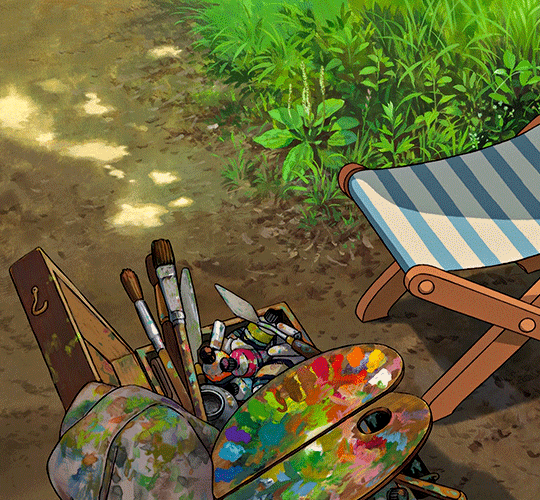





STUDIO GHIBLI + ART 🎨
Kiki’s Delivery Service (1989)
The Wind Rises (2013)
My Neighbor Totoro (1988)
When Marnie Was There (2014)
33K notes
·
View notes
Photo








Anyone who can quote Thomas More is well worth the effort. The Prince has read Utopia? I found it sentimental and dull. I confess, the plight of the everyday rustic bores me. I gather you do not converse with many peasants. Certainly not, no! Naturally. Excuse me, Sire, but there is nothing natural about it. A country’s character is defined by its everyday rustics, as you call them. They are the legs you stand on. That position demands respect, not… Am I to understand that you find me arrogant? Well, you gave one man back his life… but did you even glance at the others?
Ever After (1998) dir. Andy Tennant
13K notes
·
View notes
Text
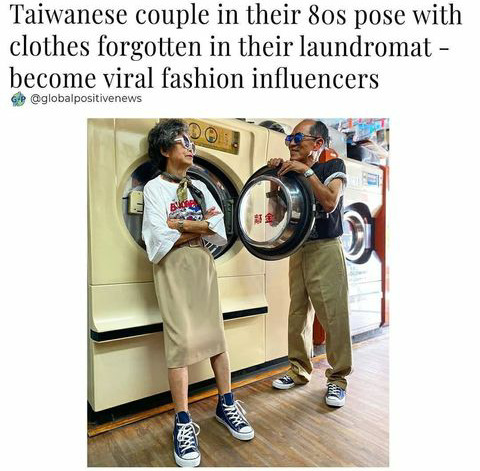
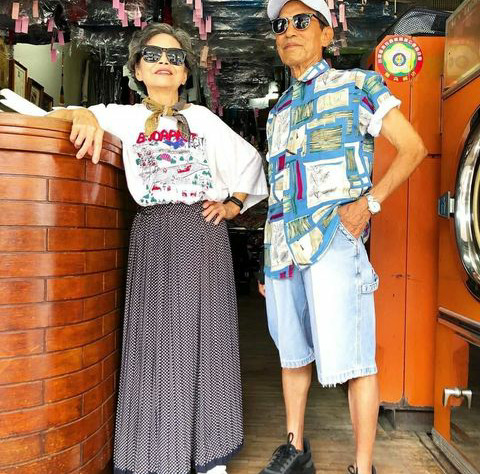

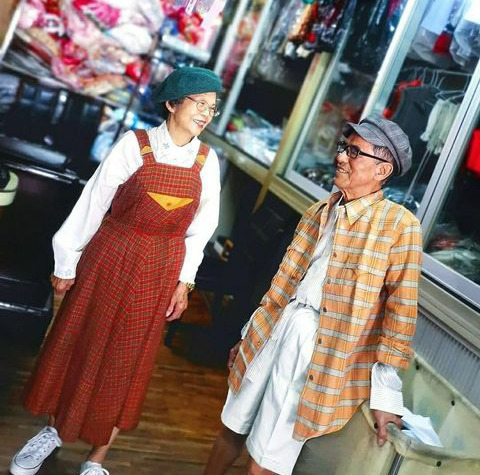


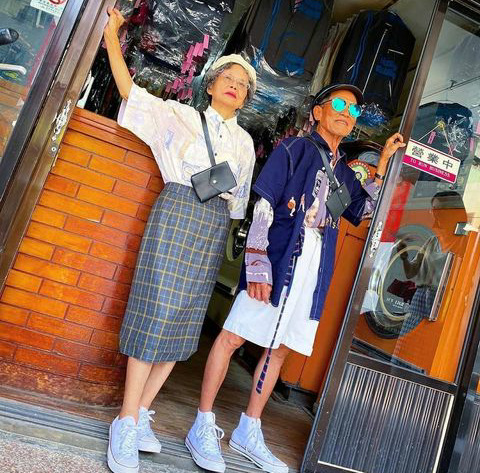

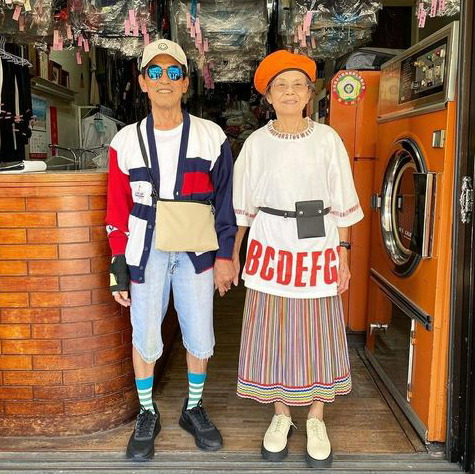

Imagine being in your 80s and looking this good 😭 they so badass
91K notes
·
View notes
Text
Guys, if you want to be a good artist and storyteller you need to absorb other media and influences beyond popular comics and movies and video games. Hell, even beyond visual art. Read novels, science articles, history books. Listen to podcasts, watch documentaries. Dip into different disciplines. Explore stuff outside your everyday. What you create and the pool of ideas you can pull out of is expanded by the knowledge you gain. Don’t do yourself a disservice by limiting your library. You never know when some weird shit you read about mushrooms could end up inspiring you or helping you solve a design/story problem.
93K notes
·
View notes
Text
Meet The Designer Who Makes 'Mrs. Maisel' Look So Marvelous
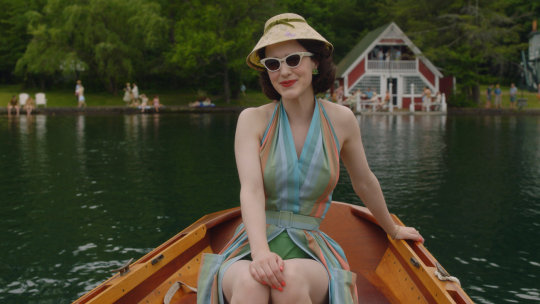
It will come as no surprise to fans of The Marvelous Mrs. Maisel that the designer behind the show’s vibrant, period-perfect ‘50s and ‘60s outfits works in a studio that is completely awash in color — from thousands of fabric swatches to a full spectrum of coats. Donna Zakowska has won two Emmy Awards for her work on the hit Amazon TV series and on Tuesday night, she’s up for an award from the Costume Designers Guild.

“I come from a painting background,” Zakowska explains. “I myself am personally very excited by color all the time. … I do put a lot of effort, a lot of time, into figuring out a scene like: What would that color be there? What would make sense? … There’s always a sense of a palette.”
Listen to or read the rest of the story at NPR.org
810 notes
·
View notes